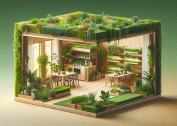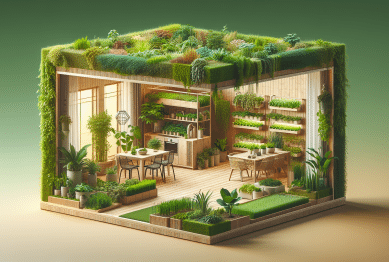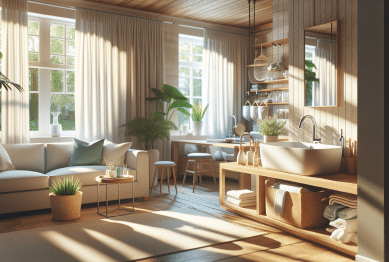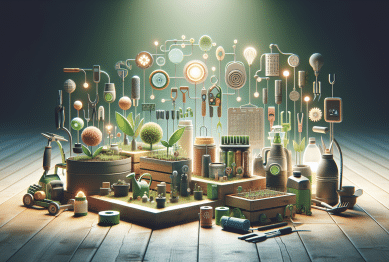As climate change and environmental degradation become more pressing concerns, many homeowners are seeking ways to reduce their environmental footprint. Designing your home with sustainability in mind not only helps preserve natural resources but also creates a healthier and more energy-efficient living space. In this article, we’ll explore practical steps you can take to make your home more sustainable, from energy-efficient design to sustainable materials and eco-friendly appliances.
Why Sustainable Home Design Matters
Sustainable home design refers to creating living spaces that minimize environmental impact while optimizing energy efficiency, water conservation, and indoor air quality. By incorporating eco-friendly features into your home, you can reduce utility costs, lower your carbon footprint, and contribute to a more sustainable future.
Key Benefits of Sustainable Home Design
-
Energy Efficiency: Sustainable homes use less energy for heating, cooling, and lighting, leading to lower utility bills and a reduced environmental footprint.
-
Reduced Waste: Sustainable design emphasizes using materials that are durable, recyclable, and ethically sourced, helping to reduce waste.
-
Healthier Living Environment: By using non-toxic materials and ensuring good indoor air quality, sustainable homes promote the health and well-being of residents.
-
Long-Term Savings: Although upfront costs for sustainable design elements can be higher, long-term savings through energy efficiency, lower maintenance, and reduced utility bills make it a worthwhile investment.
For more on the benefits of sustainable home design, check out Green Building Advisor’s Guide to Sustainable Homes.
Key Principles of Sustainable Home Design
1. Prioritize Energy Efficiency
One of the most important aspects of sustainable home design is maximizing energy efficiency. By optimizing your home’s energy use, you can significantly reduce your environmental impact and lower utility costs.
-
Passive Design: Incorporate passive design principles such as maximizing natural light, using proper insulation, and placing windows and vents strategically to reduce the need for artificial heating and cooling.
-
Energy-Efficient Windows and Insulation: Install double or triple-glazed windows to reduce heat loss and improve insulation to keep your home warm in winter and cool in summer.
-
Smart Thermostats and Energy Management Systems: Install smart thermostats that learn your habits and optimize heating and cooling systems for maximum efficiency.
For more on energy-efficient home design, see Energy.gov’s Guide to Energy Efficient Home Building.
2. Choose Sustainable Building Materials
The materials you use in your home play a significant role in its sustainability. Opt for eco-friendly, recycled, or locally sourced materials that minimize environmental impact.
-
Recycled Materials: Use reclaimed wood, recycled steel, and other repurposed materials to reduce waste and minimize the need for new resources.
-
Low-Impact Flooring: Consider using sustainable flooring options such as bamboo, cork, or reclaimed wood, which have a smaller carbon footprint than traditional hardwood floors.
-
Non-Toxic Paints and Finishes: Choose paints, stains, and finishes that are low in volatile organic compounds (VOCs), which can negatively impact indoor air quality.
For more on sustainable building materials, read The Spruce’s Guide to Eco-Friendly Building Materials.
3. Focus on Water Conservation
Water conservation is a crucial element of sustainable home design. By integrating water-saving technologies and systems, you can significantly reduce your water usage and minimize waste.
-
Low-Flow Fixtures: Install low-flow faucets, showerheads, and toilets to reduce water consumption without sacrificing performance.
-
Rainwater Harvesting: Set up a rainwater harvesting system to collect and store rainwater for irrigation or even for household use (if filtered appropriately).
-
Efficient Landscaping: Choose drought-resistant plants and use mulching techniques to minimize water usage in your garden or yard.
For more on water conservation at home, see EPA’s Guide to Water Efficiency.
4. Invest in Renewable Energy
Incorporating renewable energy sources into your home is an excellent way to reduce your reliance on fossil fuels and minimize your home’s carbon footprint.
-
Solar Panels: Install solar panels on your roof to generate clean, renewable energy and reduce your electricity bills. Solar power is one of the most popular renewable energy sources for homes.
-
Solar Water Heating: A solar water heating system uses the sun’s energy to heat water for your home, reducing the need for gas or electric water heating.
-
Wind Energy: If you live in a suitable location, small-scale wind turbines can provide renewable energy for your home.
For more on renewable energy options for your home, check out The Solar Energy Industries Association’s Guide.
5. Create a Healthy Indoor Environment
Sustainable homes are not only energy-efficient but also focus on creating healthy living environments. By using non-toxic materials and improving ventilation, you can enhance indoor air quality and overall well-being.
-
Ventilation: Install proper ventilation systems, including exhaust fans in kitchens and bathrooms, to reduce moisture buildup and improve air quality.
-
Natural Lighting: Maximize natural light by using strategically placed windows, skylights, and glass doors to reduce the need for artificial lighting.
-
Indoor Air Quality: Use air-purifying plants, avoid materials that emit harmful chemicals, and incorporate non-toxic paints and finishes to improve indoor air quality.
For more on creating healthy homes, see The Healthy Home Economist’s Tips.
6. Make Sustainable Home Improvements Over Time
You don’t have to complete your entire sustainable home project all at once. Start with small, affordable changes and gradually incorporate more sustainable features over time. This approach allows you to spread out costs and make adjustments based on your lifestyle and needs.
-
Upgrade Appliances: Replace old appliances with energy-efficient models, such as Energy Star-rated refrigerators, dishwashers, and washing machines.
-
Add Insulation: If your home lacks proper insulation, consider adding more in key areas such as attics, walls, and floors to improve energy efficiency.
For more on affordable home improvements, read The Balance’s Guide to Sustainable Home Improvements.
Conclusion: Designing a Sustainable Future
Designing your home with sustainability in mind is an investment in both your future and the planet’s future. By choosing energy-efficient systems, eco-friendly materials, and water-saving technologies, you can create a living space that benefits both you and the environment. Remember, sustainable home design is not about making radical changes all at once—it’s about taking incremental steps toward a more sustainable and healthy lifestyle.
References:
-
Energy.gov. (2021). Energy Efficient Home Building. Retrieved from https://www.energy.gov/energysaver/design
-
The Spruce. (2021). Eco-Friendly Building Materials. Retrieved from https://www.thespruce.com/eco-friendly-building-materials-4863959
-
EPA. (2021). Water Efficiency at Home. Retrieved from https://www.epa.gov/watersense










